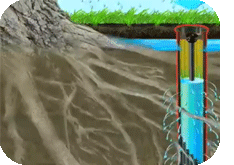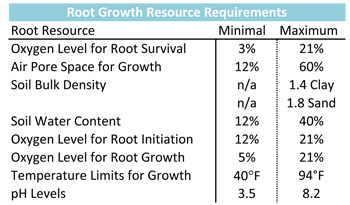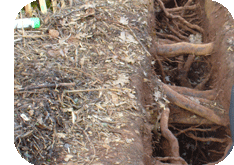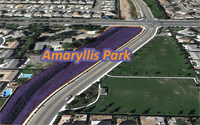Root Watering / Aeration Tubes - Effective or Not?
Author: Chad Kennedy, Landscape Architect, ASLA
 The question surrounding whether or not root watering and aeration tubes actually improve mortality rates and health of trees is widely discussed in the horticulture and arboriculture professions. Some profess that they are a waste of money and have no positive effect on trees. Others will try to convince you of their myriad benefits. As an arborist and horticulturist myself I have used and specified the use of root watering devices for years. It should be understood, however, that these devices should not be treated as universal solutions to all tree health issues and planting applications. They should, however, be used when soil and site conditions warrant the initial up-front investment.
The question surrounding whether or not root watering and aeration tubes actually improve mortality rates and health of trees is widely discussed in the horticulture and arboriculture professions. Some profess that they are a waste of money and have no positive effect on trees. Others will try to convince you of their myriad benefits. As an arborist and horticulturist myself I have used and specified the use of root watering devices for years. It should be understood, however, that these devices should not be treated as universal solutions to all tree health issues and planting applications. They should, however, be used when soil and site conditions warrant the initial up-front investment.
 Soil Solution Make-up: The plant root zone is filled with soil solutions vital to root and plant growth. These solutions are combinations of several ingredients, the most important of which are water nutrients and oxygen. Plant health can significantly and rapidly deteriorate in the absence or limitation of one or more of these ingredients. The table to the right1 is a general breakdown of a few of the soil requirements for root growth. A detailed description of nutrient requirements can be found in the article referenced at this link.
Soil Solution Make-up: The plant root zone is filled with soil solutions vital to root and plant growth. These solutions are combinations of several ingredients, the most important of which are water nutrients and oxygen. Plant health can significantly and rapidly deteriorate in the absence or limitation of one or more of these ingredients. The table to the right1 is a general breakdown of a few of the soil requirements for root growth. A detailed description of nutrient requirements can be found in the article referenced at this link.
Soil Conditions Warranting Mitigation Efforts: To the detriment of modern urban forests, most urban soils have been moved, replaced, contaminated and subjected to high levels of compaction resulting in limited space for rooting, limited soil gas exchange, obstructed drainage and composition variability. In urban environments such as these, the average life span of trees has been estimated at a dismal ten years.3 Soil compaction reduces open pore spaces in the soil profile, ultimately restricting root growth by limiting access and quantities of necessary nutrients, water and air.
Other soil conditions limiting resources to roots include high clay content in the soil and high density plantings or grasses within driplines of trees. In many cases, turf grasses in particular utilize water, air and nutrients in the upper soil profile before tree roots can gain access. This scenario forces tree roots to stay close to the surface where they can compete for resources.

Root Watering and Aeration Devices as Mitigation Measures: Several studies have been performed on root watering and aeration devices to determine if they are effective at improving health of trees. One of the essential characteristics of these tubes is high porosity or gas and water exchange surface area. There are many products on the market that are labeled as root watering devices but have only a few perforations from which gas and water can be exchanged. These products would be much less effective than mesh tubes with ample void space. One study by the Davey Tree Research Station noted that these mesh tube devices, "should be a good tool to use in areas where hardscape, like concrete exists."2
Another study compared two tree irrigation systems in healthy soils. One was a traditional drip system; the other was a mesh tube root watering system. Though both systems resulted in healthy trees, trees irrigated with mesh tubes grew forty eight percent (48%) more roots in the lower half of the root ball after only three months of establishment. Roots in the upper soil profile were equal. After thirteen months of establishment the same trees had produced a total of eighteen percent (18%) more roots than those irrigated by a drip system. The study also suggested that tube socks may be a long-term benefit for continued water and gas exchange.2 Though these studies showed that tubes can create healthier trees it is important to remember that they are most effectively utilized where compacted and slow draining soils are present or where surface vegetation is dense. In these areas, the eighteen percent (18%) increase in roots, can be the difference between a healthy and unhealthy tree.
When researching different tube devices, identification and selection based on the following characteristics is critical:
- High surface to soil contact-The soil must be able to conform to the tube with as much surface area as possible. The more surface area the better.
- High permeability-Mesh or highly perforated tubes provide the highest potential for water/gas exchange. The more void space the better.
- Tube strength-Strong tubes are necessary to avoid collapse during installation or by pressure from the surface (cars and construction equipment)
- Locking lids-In public spaces, perforated and preferably reinforced locking lids are essential to avoid vandalism and premature filling of the tube.
- Irrigation flow rates-Proper irrigation is also imperative for success. Water must be applied at the surface of newly planted root balls as well to keep them moist and to encourage growth at all depths of the soil profile. Water should be run long enough to fill the tubes and the soil well at the surface.
Though the discussion about the effectiveness of root watering tubes will most likely continue, there are studies that show they are effective and the arguments for their use are grounded in solid horticultural science. For now, they have a place in my arsenal of methods, where appropriate, to help grow healthy urban forests.

 Soil Solution Make-up: The plant root zone is filled with soil solutions vital to root and plant growth. These solutions are combinations of several ingredients, the most important of which are water nutrients and oxygen. Plant health can significantly and rapidly deteriorate in the absence or limitation of one or more of these ingredients. The table to the right1 is a general breakdown of a few of the soil requirements for root growth. A detailed description of nutrient requirements can be found in the article referenced at this
Soil Solution Make-up: The plant root zone is filled with soil solutions vital to root and plant growth. These solutions are combinations of several ingredients, the most important of which are water nutrients and oxygen. Plant health can significantly and rapidly deteriorate in the absence or limitation of one or more of these ingredients. The table to the right1 is a general breakdown of a few of the soil requirements for root growth. A detailed description of nutrient requirements can be found in the article referenced at this 

